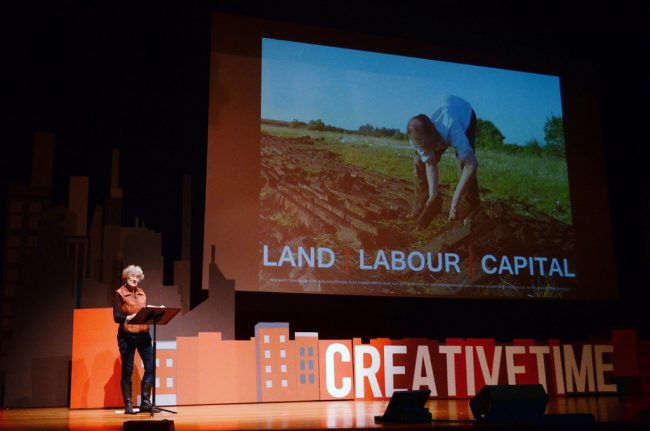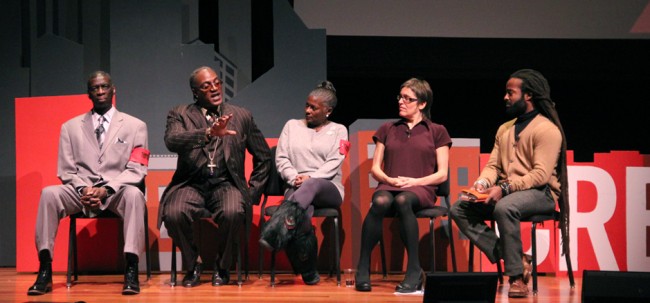
We are celebrating 15 years — and counting — of stories that are deeply researched and deeply felt, that build a historical record of what the city has been.
We are celebrating 15 years — and counting — of stories that are deeply researched and deeply felt, that build a historical record of what the city has been.
Last weekend, Creative Time, a leading nonprofit in the presentation of public art in New York City and worldwide, held its fifth annual Summit, this year addressing the theme of Art, Place, & Dislocation in the 21st Century City. The conference explored a premise that’s well known to Omnibus readers: that culture and art — in both productive and problematic ways — are active ingredients in the creation of our urban environment and our experience of it. The Architectural League has been active on this front of late. We’ve repeatedly delved into this concept here on Urban Omnibus, most recently through our series articulating and analyzing Naturally Occurring Cultural Districts across the five boroughs. And the recent League report Success Looks Different Now explores contemporary manifestations of New York City’s cultural vitality and its relationship to the physical city. The Summit’s consideration of how artists can help to subvert power structures and contribute to a more socially just city is important and inspiring, and its awareness of the creative community’s potential to destabilize neighborhood continuity is laudable: for all the talk of “place,” there was a palpable recognition of the threat of displacement via artist-led gentrification. While the full collection of artists, architects, urbanists, writers, theorists, and organizers proved up to the task of staking out this varied and complex territory (full presentations available here), find below a few of the highlights from the Summit’s presenters.

Lucy Lippard is an influential art critic, writer, curator, and activist. Her keynote address reminded the audience that placemaking is often a presumptuous process on the part of artists, designers, and planners, and argued for a revision to the idea that the local is sentimental or nostalgic. | Photograph by Christos Katsiaouni, courtesy of Creative Time
Neil Brenner, Professor of Urban Theory at the Harvard Graduate School of Design, helpfully framed the conversation around placemaking and cultural production as a tool for community development in a keynote address Friday morning. Brenner contextualized his analysis of placemaking — defined by the National Endowment for the Arts as the strategic shaping of the physical and social character of a place around art and cultural activities by interdisciplinary partners — in the historical relationship between place and capital. In our recent history of global economic crises and the use of state-imposed austerity as response, Brenner argued that, in the context of the city, the state has often been mobilized for privatization, gentrification, and polarization. In this environment, cultural production is instrumentalized for the benefit of economic growth in ways that rarely benefit its producers and can destroy the place from which it arises. Brenner called for a counter-politics of place that democratizes both access to place and the power to produce places. But Brenner does see pitfalls in this democratization of place: in addition to the potential for co-optation or destruction, specific localities can become enclaves while the systems this place-politics seeks to change continue unabated in the surrounding area.
Continuing on the subject of placemaking, Lize Mogel, an artist who challenges traditional histories of place through counter-cartography, defined “mega-events” as placemaking gone wild. Such events — World’s Fairs, the Olympics, and the World Cup — use the language of placemaking to transform the urban environment radically through “beautification” efforts and the creation of new infrastructure meant to serve a temporary city. In the process, new laws are enacted and development fast-tracked, often based strictly on elite-led planning that harms particularly vulnerable populations.
In line with Brenner’s argument for the democratization of the power to produce place and in contrast to the image of the mega-event that Mogel articulated, architect Alfredo Brillembourg’s vision of an urban future is of an architecture created in collaboration with its users. The idea follows directly from the Torre David, a 45-story, unfinished office tower in the middle of Caracas that has since been repurposed by squatters into homes, businesses, and community gathering spaces. Brillembourg’s practice, Urban-Think Tank, views this model — of a frame that residents can ultimately fill in based on their needs — as a producer of design innovation that beneficially undermines an architectural culture too focused on elite perspectives.
Artist Madeline Blount recounted an occupation of another space: the buffer zone between the Greek- and Turkish-controlled halves of Cyprus. The zone, patrolled by the UN, cuts the capital city of Nicosia in half, leaving previously inhabited urban locales empty since 1974 while the divided city still sits above a unified water and sewer system. Blount explored how physically occupying the space through dance and performance could change it, and recounted the experience of temporary reunification when Occupy the Buffer Zone took over a small area of the demilitarized zone. These small transgressions speak to the marked disconnect between local experience and the geopolitical sparring that’s divided the island. Furthermore, they raise the question of how residents’ desires might be interjected into decisions that happen on a political level far removed from the local.
While the buffer zone that Blount explored is particularly visible, renowned writer Rebecca Solnit turned her attention to a tool long used to make invisible geographies and systems known: maps. While maps have certainly proliferated in daily life through mobile technologies, examples like Google Maps and the bespoke cartographies it constructs based on user behavior are, to Solnit, a strait jacket. She sees the real value in maps not to direct, but to allow the possibility to explore counter-narratives of place. Solnit presented some of the ways she’s worked with designers and activists in San Francisco and New Orleans to create such maps: one shows the corporatization of communities by charting the private bus routes of Google and other Silicon Valley companies, another describing the prisons of Louisiana as suburbs of center city New Orleans due to their significant population of incarcerated residents of the area.

From left to right: Darrell Cannon, Reginald Berry, Sr., Brenda Townsend, and Laurie Jo Reynolds of Tamms Year Ten, in conversation with the musician and former inmate John Forté (far right) | Photo by Cassim Shepard
Inhumane incarceration took center stage when Laurie Jo Reynolds received the Leonore Annenberg Prize for Art and Social Change; she was one of two winners along with the Palestinian artist and curator Khaled Hourani. Reynolds accepted the award on behalf of Tamms Year Ten, a volunteer grassroots legislative campaign to reform or close Tamms supermax prison in Illinois. Through her “legislative art” work, Reynolds contributed to the closing of the prison earlier this year. Despite the branding of the work as art, the lobbying and other political tools used in the campaign appear more like traditional, particularly effective activism. Reynolds did outline some of the ways the initiative utilized art practice to communicate with the isolated prisoners: the team solicited requests for images, real or imagined, from the prisoners and created, either through documentation or collage, those images to be sent to them. As the powerful testimony of three other members of the Tamms Year Ten team — Darrell Cannon and Reginald “Akkeem” Berry, Sr., two survivors of Tamms, and Brenda Townsend, the mother of a former Tamms inmate — demonstrated, the distinction between activism and art in this context is purely academic. It has little bearing in the context of such meaningful change.
In another instance of interdisciplinary practice, Levan Asabashvili, a Georgian architect and activist, explained how his group Urban Reactor works to counteract the government-imposed “beautification” and reconstruction of towns as a component of a larger neoliberal agenda. Asabashvili has turned his design eye not toward the construction of buildings but to the reformation of processes to create an appreciation and mechanisms for the preservation of what is currently under threat of erasure. An integral part of the work is an alternative education in planning and architecture, which Urban Reactor is advancing through a library project and experimental spaces for dialogue.
The blurring borders of art and activism displayed by the varied presenters and their distinct approaches to urban issues bode well for the future of art practice — and, more importantly, for the future of our communities. As always, the critical minds and creativity of artists are very much needed in grappling with the incredible social issues we face, particularly issues of race, class, and inequality. Creative Time’s leadership in acknowledging artists’ obligations as citizens and providing examples of effective ways of doing so is an especially strong contribution to this agenda.
The views expressed here are those of the authors only and do not reflect the position of The Architectural League of New York.